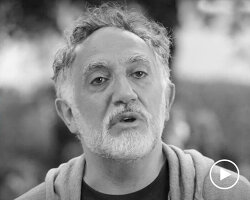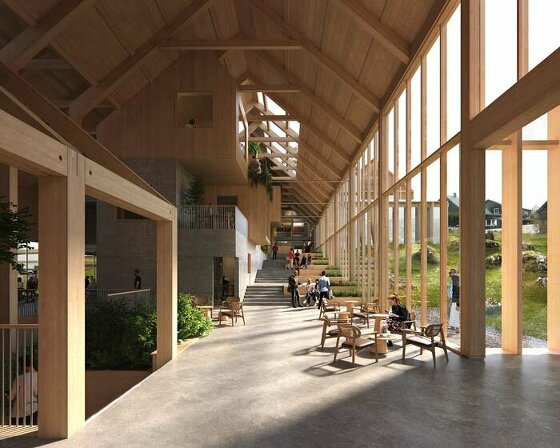norman foster and holcim AT THE 2023 venice BIENNALE
The Norman Foster Foundation and manufacturing expert Holcim closely collaborate to bring safety, comfort and well-being to displaced communities with Essential Homes. Presenting at the 18th Venice Architecture Biennale, which runs from May 20 to November 26, 2023, the temporary exhibition and prototype examines the global issue of the refugee crisis and conceptualizes sustainable solutions. designboom sat down with Sir Norman Foster to learn more about the team’s design approach, the challenges they encountered, and their vision for addressing the urgent needs of displaced populations.
‘The subject was issues of urbanism, sustainability and the city, but the focus was primarily on the refugee crisis and what we can do to respond to it. At the initial workshops, we erected the current response to a refugee crisis, a tent. During the process of putting it together, we would drop important pieces and scramble around on the floor, leading us to question premise of tents, even sophisticated ones, being the best solution,’ says the British architect and president of the Norman Foster Foundation in an interview with designboom. (read the interview in full below)

all images by Chiara Becattini, unless stated otherwise
ESSENTIAL HOMES: finding solutions through sustainable means
In the design phase of Essential Homes, the Norman Foster Foundation imagined a better future, where displaced people could be offered a comfortable and more dignified living environment. Construction experts Holcim focused on the materiality choices, considering the sustainability qualities these temporary dwellings could hold. The Essential Homes prototype was built with ECOPact low-carbon concrete and Elevate insulation.
‘When you go inside, you realize this could be a nice place to live. It’s tall, generous, and has a great quality of light, views, and intimate spaces. You can build it within three or four days without requiring skilled labor. In the collaboration with Holcim Foundation, we used their products to create a design where the carbon imprint is a 70% reduction over its equivalent with traditional construction methods and we demonstrated that through the prototype,’ Foster elaborates on the essential homes design and the collaboration with Holcim.

providing physical safety, low-carbon rollable concrete sheets serve as an external shell
the design of THE HOUSING PROTOTYPE
The Essential Homes design endorses a natural catenary shape. Thin, low-carbon concrete canvas is rolled up and transported to the site. Here the material is placed over a grid structure in a vaulted shape, overlapping so as to make the structure leak-proof. Finally, the concrete canvas is watered and left to dry and rigidify, hardening fully within 24 hours. The grid can then be removed, and the form will be held, with an estimated lifespan of 20 years.
‘It’s eminently recyclable. One of the next steps will be exploring the potential for the canvas to be reused, recycled, and reappear. In the workshop, there was an underlying ideology that if you’re really going to respond to a humanitarian crisis, you have to sacrifice any idea of beauty. It’s an unaffordable luxury. The response from visitors to the prototype has been ‘I’d love one of those. I’d love to be in one of those,’ describes Foster on the design and response to Essential Homes.

each component of the Essential Homes model can be reused or recycled.
the future of essential homes
During the Venice Architecture Biennale 2023, the Essential Home Research project is unveiled at the Time Space Existence exhibition organized by the European Cultural Center. A prototype displayed in the Marinaressa Gardens is supported by an exhibition hosted in Palazzo Mora. In line with the Biennale’s theme ‘Laboratories of the Future,’ this research project opens the conversation on how to provide essential housing for all in a sustainable way. The exhibits describe a work-in-progress, rather than a conclusion, showcasing one possible way that Holcim’s innovative technologies can be used in construction.
‘We started by dealing with the refugee crisis and by helping displaced people, but we can also see this technology being used for affordable housing. Holcim’s goal is to make the sustainable building an available solution for all. By expanding to affordable housing, you address far bigger volumes, which can become locomotive in driving a better and more sustainable world,’ comments Edelio Bermejo, Group Head of R&D at Holcim, on the future prospects of the building material beyond the Biennale.

Sir Norman Foster speaks at the 18th Venice Architecture Biennale about Essential Homes | image ©designboom
interview with Norman Foster
designboom (DB): What are the issues that essential homes research aims to resolve?
Norman Foster (NF): The subject revolved around issues of urbanism, sustainability and the city, but the focus was primarily on the refugee crisis and what we can do to respond to it. At the initial workshops, we erected the current response to a refugee crisis, a tent. During the process of putting it together, we would drop important pieces and scramble around on the floor, leading us to question the premise of tents, even sophisticated ones, being the best solution.
I believe everything you see was provoked by that. However, what’s happened is that I believe everyone who interacts with it, including those of us who have been most involved, has realized that we have touched upon something that relates not only to the refugee crisis but also to the homeless crisis. This crisis is afflicting some cities, particularly in North America, where you literally have hundreds of thousands in makeshift tents.
When you go inside, you realize this could be a nice place to live. It’s tall, generous, and has a great quality of light, views, and intimate spaces. The lower part of the arch, which is niche-like, is perfect for a writing desk or a double bed, with a single bunk above, along with a small bathroom or kitchen. And you realize that it could be desirable and easily affordable, with an estimated cost of 20,000 euros. You can build it within three or four days without requiring skilled labor. The carbon imprint is a 70% reduction over its equivalent traditional construction methods and we demonstrated that through the prototype.

DB: Is the essential homes design made for a particular climate? Or is it something that you can imagine being suitable all over the world?
NF: If you go to the exhibition, you’ll see there three big images, the ones that I showed in the last presentation. The response can be tunable, depending on the environment, whether it’s a desert, tundra, or extreme cold with snow. In the cold climate version, you would include more insulation and open up to the sun to capture its warming energy. In a desert environment, you would explore ways to reduce solar gain, such as incorporating evaporative cooling.
You might be looking at an extra level, maybe a shade over, to create the equivalent of a double roof.
So if this really takes off — as we’re currently discussing in the development program, the team that has miraculously delivered this in just nine months— we need to consider how to proceed with its scaling. In an ideal world, the end result would probably be a warehouse next to an airstrip with efficient logistics for containerization. We would carefully handpick the components for each specific deployment location, allowing for tunable versions tailored to the climate and culture of that area.

introducing a resilient substitute for tent shelters
DB: In this project, Norman Foster Foundation intensively collaborated closely with Holcim, how was it to work with them?
NF: The collaboration with Holcim started by utilizing their products to demonstrate how a small group of engineers could create a prototype cell, which became a pavilion here in Venice. After a significant gap, the company, along with its research arm, sponsored a workshop that brought us together intellectually. We’re excited by the students’ response. They had no idea at the time that the workshop was funded, covering their expenses, including airfare, meals, and bringing together various experts.
They were motivated to the extent of seeing the potential to take it a stage further and realize a prototype. Through our collaboration, which we immediately expanded, we worked with Bauer on the new pavilion that was constructed approximately ten years ago. In a different capacity, I had previously worked with Empty on projects through our practice. There is no connection between the practice and the foundation; however, Bauer later became associated with Empty. It seemed appropriate to have a contractor who understood our standards and shared a sympathetic approach. Empty and Bauer has been familiar with some of our design obsessions over the years, particularly regarding detail and finish. Thus, we had the necessary materials, research, scientists, builders, architects, and a tiny team led by Alberto and Miguel. Additionally, we had model makers within the foundation. So we had the skills, but as I described earlier, I don’t know if we had crises along the way. At one point, I was close to calling him and saying we may not make it in time. However, i think it’s a tremendous achievement on everybody’s part. There is now a meeting of minds and values.

a full-scale prototype for emergency housing
DB: The project is aimed at providing suitable shelter with speed for, what are hopefully, temporary tenants, what happens to the structures after they have fulfilled their use?
NF: It’s eminently recyclable. One of the next steps will be exploring the potential for the canvas to be reused, recycled, and reappear. In the workshop, there was an underlying ideology that if you’re really going to respond to a humanitarian crisis, you have to sacrifice any idea of beauty. It’s an unaffordable luxury. The response from visitors to the prototype has been ‘I’d love one of those. I’d love to be in one of those.’ It brings the spiritual aspect of architecture into the most basic human response to a crisis. This is unexpected quality, to find excitement in staying in such a place, as you’d normally want to leave as soon as possible,
When you look at the tent, you know it’s the best. It’s better than any other tent you can find, but in the end, it’s just a piece of cloth with no windows. You may consider investing a bit more money to improve it, but you never really think whether you could create a place where you’d really want to be. I believe that is one of the unexpected consequences of the endeavors.


the interior is generous and neat, with great quality of light

image ©designboom













project info:
name: Essential Homes
design: Norman Foster Foundation | @normanfosterfdn and Holcim | @holcim.ltd
location: Time Space Existence exhibition, during the Venice Architecture Biennale 2023
HOLCIM (5)
NORMAN FOSTER FOUNDATION (3)
TEMPORARY PAVILIONS (380)
VENICE ARCHITECTURE BIENNALE 2023 (39)
PRODUCT LIBRARY
a diverse digital database that acts as a valuable guide in gaining insight and information about a product directly from the manufacturer, and serves as a rich reference point in developing a project or scheme.



















